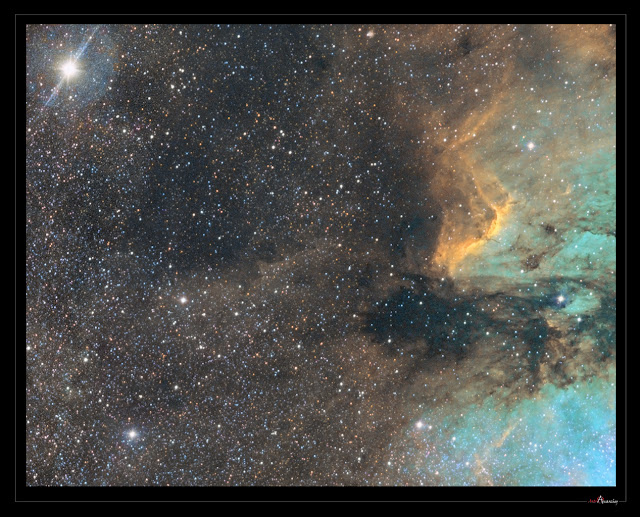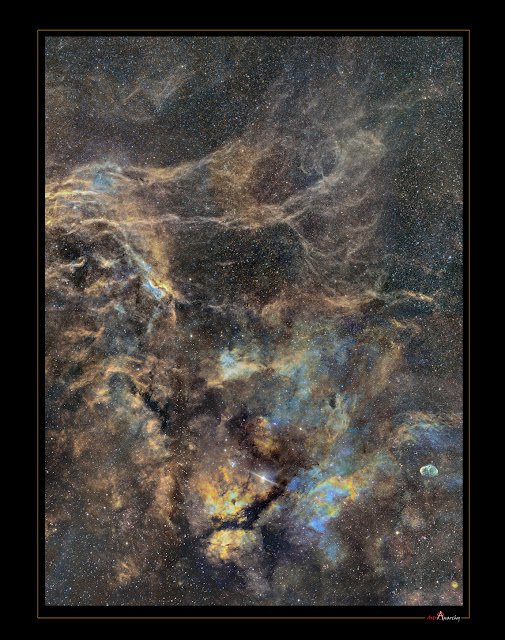COPYRIGHT, PLEASE NOTE
All the material on this website is copyrighted to J-P Metsavainio, if not otherwise stated. Any content on this website may not be reproduced without the author’s permission.
BUY A MUSEUM QUALITY POSTER
BUY A POSTER:https://astroanarchy.zenfolio.com/
Wednesday, November 23, 2011
A two frame panorama from Cygnus
A panoramic image from the Butterfly to the Crescent Nebula
In constellation Cygnus
Click for the large image
This is a two panel mosaic, cropped from the large, eight panel, Cygnus mosaic.
Image is in mapped colors from an emission of ionized elements,
Red=Sulfur, Green=Hydrogfen & Blue=Oxygen
I have published some images composed from the material, I collected for the large panorama of Cygnus Nebulae. Original size for this high resolution image is ~7000x3000 pixels. Technical details can be found from an older post, Cygnus project, the grande finale.
A detail from the image above.A narrow stripe, a detail from the Cygnus mosaic
This image is a narrow cut from my previous post, Cygnus project, the grande finale.
Image is reduced a lot, original, full size, mosaic is 14.000x10.000 pixels.
Image stripe in this post is shown at resolution 640x2700, it might take few moments to load, sorry.
The idea is to show, what kind of resolution a well collimated and focused, 200mm f1.8, high end camera lens can deliver.
Image stripe in this post is shown at resolution 640x2700, it might take few moments to load, sorry.
The idea is to show, what kind of resolution a well collimated and focused, 200mm f1.8, high end camera lens can deliver.
A cropped and reduced stripe from the Cygnus mosaic in mapped colors.
Image is combined from emissions of ionized elements, Red=Sulfur, Green=Hydrogen & Blue=Oxygen.
Large area and technical details can be seen in my previous post, Cygnus project, the grande finale.
Tuesday, November 22, 2011
Cygnus project, the grande finale
Mosaic of dancing Nebulae
NOTE, this is a largish file, 1400x1950 pixels and 2,8 meg.
Direct link to a 2000x3000 pixel version HERE. (7,5 meg)
(Original one is ~14.000x10.000 pixels)
Direct link to a 2000x3000 pixel version HERE. (7,5 meg)
(Original one is ~14.000x10.000 pixels)
It took couple of Months to shoot all the needed frames for this mosaic and I did use every possible clear moment. This mosaic image has eight full size (3500x2500 pixels) panels and the final image has a massive size of 7.000 x 10.000 pixels. For every panel, I shot three different images of emission of ionized elements, Hydrogen, Sulfur and Oxygen. (H-a, S-II and O-III). This image is a mapped color composition showing Hydrogen as Green, Sulfur as Red and Oxygen as Blue.
Image spans about 10 degrees horizontally and 14 degrees vertically. (Apparent size of the full Moon is ~30 arc minutes = 0,5 degrees. Full moon fits to this are at about 480 times!)
Generally this mosaic took a lots of work to finalize and it was kind of difficult to process since the star field is so very dense at galactic plane. Overall I'm happy with this result!
Northern constellation Cygnus (aka "Norther Cross") locates at the plane of our Milky Way and it's a treasure box of beautiful nebulae. Bright supergigant star Gamma Cygni can be seen at center Right, next to the Butterfly Nebula, IC 1318. The bright Blueish spot at upper Right is the Crescent Nebula, NGC 6888.At top Left, a beautiful open cluster, NGC 6819 , can be faintly seen. (It's well resolved in full res. image)
Two bright objects at bottom middle are Sh2-112 and a bluish Sh2-115. At bottom Right are parts of the North America and Pelicän nebulae visible. The propeller Nebula can be seen at center left. There are many other objects in this large field.
Overlay with a star map.
Closeups from the large panorama
Click for a large image!
Open cluster, NGC 6819, at middle, from upper Left corner of the mosaic.
I have finally teamed this f1.8 lens and now all of the stars are pinpoints to edge to edge!
Closeup from lower Right corner shows part of the North America & Pelican Nebulae.
The Crescent Nebula from upper Right.
Gamma Cygni from center Right and a part of the Butterfly Nebula.
A closeup of the "Cirrus" area from lower Left of the large mosaic.
New pictures from the panorama material
Since I now have a load of processed panels for the panorama, I have composed some new individual high resolution images out of them.
Click for a large image!
I started this project by shooting a Three panel mosaic of "Cirrus of Cygnus"
"Cirrus of Cygnus", this area can be seen at Left in an image at top.
A "Natural" Color composition from the emission line channels
R=80%Hydrogen+20%Sulfur, G=100%Oxygen and B=85%Oxygen+15%Hydrogen to compensate otherwise missing H-beta emission. This composition is very close to a visual spectrum.
Click for a large image!
Large Eight panel mosaic in natural color composition from the NB channels
A two panel mosaic from the same material.
An animation, nebula with and without stars
This animation will show more details in the nebula, since human brains gets easily fooled to see shapes in a cloud of dots, like stars are. Please, let the animated GIF load for few seconds to see it animated. ( 1,2 meg)
Click for a large image!
I think, that dim Blueish arch like formations, seen at top Left, are some reflections.
8,5nm O-III filter is too wide. to block all of the light pollution. and reflections can happened.
Technical details
I have used a very fast camera optics, Canon EF 200mm f1.8, full open to collect all the data in this mosaic. Due that, total exposure time is relatively short, ~15h, there are some very dim formations clearly visible.
Processing work flow:
Image acquisition, MaxiDL v5.07.
Stacked and calibrated in CCDStack2.
Levels, curves and color combine in PS CS3.
Optics, Canon EF 200mm camera lens at f1.8
Camera, QHY9
Image Scale, ~5 arcseconds/pixel
Guiding, Meade LX200 GPS 12" and a Lodestar guider
Filter, Baader 7nm H-alpha and Baader O-III 8,5nm
Exposures for Eight panels,
Panel 1 (Top Left),
H-a, 3x900s Binned 1x1
O-III, 2x300s Binned 3x3
S-II, 2x300s Binned 3x3
Panel 2 (Top Right),
H-a, 5x900s Binned 1x1
O-III, 6x300s Binned 3x3
S-II, 6x300s Binned 3x3
Panel 3 (Upper Left),
H-a, 3x900s Binned 1x1
O-III, 3x300s Binned 3x3
S-II, 2x300s Binned 3x3
Panel 4 (Upper Right),
H-a, 4x900s Binned 1x1
O-III, 6x300s Binned 3x3
S-II, 6x300 Binned 3x3
Panel 5 (Lower Left),
H-a, 5x900s Binned 1x1
O-III, 3x300s Binned 3x3
S-II, 2x300s Binned 3x3
Panel 6 (Lower Right),
H-a, 8x900s Binned 1x1
O-III, 6x300s Binned 3x3
S-II, 6x300 Binned 3x3
Panel 7 (Bottom Left),
H-a, 6x900s Binned 1x1
O-III, 3x300s Binned 3x3
S-II, 2x300 Binned 3x3
Panel 8 (Bottom Right),
H-a, 4x900s Binned 1x1
O-III, 2x300s Binned 3x3
S-II, 2x300s Binned 3x3
Total exposure time for all channels ~15h
Total exposure time for all channels ~15h
Top of light exposures, there are calibration files shot.
H-a, 21 Flat frames
O-III, 21 Flat frames
S-III, 21 Flat frames
All filters:
99 Bias frames
19 Dark frames
Monday, November 21, 2011
Pre publishing a small sample of Cygnus mosaic
Final publication tomorrow.
A small part from an eight panel mosaic of Cygnus Nebula area.
This is kind of pre publishing for a large work, I have finalized an eight panel mosaic from the grand nebula of Cygnus constellation. I have finally tamed my super fast camera optics, Canon EF 200mm f1.8. Stars are now absolute pinpoints from edge to edge! I't wasn't an easy task, it took hundreds of iterations to match the CCD planar to the optical path at accuracy of fraction of microns . Yes, that's the needed accuracy, I almost gave up many times.
An other area from the grande mosaic of Cygnus.
Final publication tomorrow.
Subscribe to:
Comments (Atom)



























